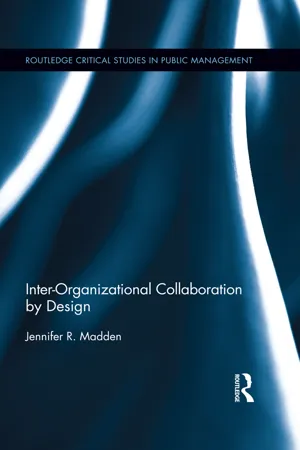![]()
1
Introduction
Although difficult, complicated, and sometimes discouraging, collaboration is recognized as a viable approach for addressing uncertain and complex problems. Inter-organizational collaborations can attract resources and increase efficiency, facilitate visions of mutual benefit that can ignite common desires of partners to work across and within sectors, and create shared feelings of responsibility. Collaboration can also promote conceptualized synergy, the sense that something will “be achieved that could not have been attained by any of the organizations acting alone” (Huxham, 2003). However, previous inquiries into the problems encountered in collaborations have not solved an important question: How can successful inter-organizational collaboration be enabled? Through exploratory sequential mixed-methods research conducted in three empirical studies, I discover how inter-organizational collaborations can overcome barriers to innovate and rejuvenate communities and understand the factors and antecedents that influence successful collaboration.
In the first study (Chapter 2), I use a grounded theory approach to identify the emergent factors involved in successful collaboration. My interviews with leaders in affordable housing as an example of inter-organizational collaborations revealed most collaborations for affordable housing encounter a common set of obstacles: funding, partnering, community, and/or government. Key findings suggest leaders of successful collaborations exhibit heightened emotional and social competencies, take actions intended to create a better future, remain mission-focused, and continuously redesign to meet ongoing challenges. Further, successful inter-organizational collaborations were innovative—creating solutions that rejuvenated their communities.
To confirm and validate the findings in the first study, I proposed a theoretical model emerging from the qualitative research, designed and empirically tested through a survey of 452 leaders and managers participating in ongoing or recently completed inter-organizational collaborations. In this second study (Chapter 3), after establishing proper reliability and validity of the constructs examined, I found design attitude (β = 0.45, p < 0.001), shared vision (β = 0.32, p < 0.001), and autonomy (β = 0.16, p < 0.01) all positively affect successful collaboration performance. The study proposed a theoretical perspective for collaborators to adopt design science (i.e., a solution-finding approach utilizing end-user-centered research, prototyping, and collective creativity) to strengthen individuals, teams, and organizations; (Madden, 2015), the language of designers, and a design attitude as an empirically informed pathway for better managing the complexities inherent in inter-organizational collaboration. This research is also the first to quantitatively validate a design attitude scale for building better collaborations.
In my third study (Chapter 4), I examine mutuality as a critical antecedent of successful inter-organizational collaboration performance and the importance of active listening in team interaction. This study uncovers the positive and significant links between mutually beneficial exploration and boundary spanning (β = 0.73, p < 0.001), design attitude (β = 0.65, p < 0.001), shared vision (β = 0.35, p < 0.001), and autonomy (β = 0.34, p < 0.001). The constructs are validated in my second quantitative study. Again, these data are revealed following the proper statistical techniques that show reliability and validity of the constructs utilized in the hypothesized model. Finally, I propose how successful collaboration performance research can contribute to the development of evidence-based strategies for creating practitioner tools (Chapter 5). I provide examples and resulting implications both as evidence and to guide practitioners (Chapter 6).
This book makes theoretical and empirical contributions to the literature on inter-organizational collaboration, extending the traditional theoretical framework to include nontraditional literature streams and theories and connecting theory to practice. Through an integrated framework, evidence-based tools and strategies for building successful collaboration is examined and articulated in real world situations where successful collaboration performance and innovation facilitates rejuvenative collaboration. This book is useful for leaders and managers in nonprofit, private, and government sectors interested in building better and more meaningful collaborations.
1.1. The Collaboration Conundrum
A change in the nature of problems has caused a pivotal shift. Contemporary problems are now indivisible (Aldrich, 1976), wicked (Rittel & Webber, 1973; Kimbell, 2011), open-ended and unstable messes (Schon, 1971; Ackoff, 1974) or meta-problems (Trist, 1983; Shapiro, 2014), suggesting that the increased difficulty of problem solving (or solution finding) now exceeds the ability of single organizations (Gray, 1985). The growing need for collaborative problem solving cannot be overstated. Yet although a viable strategy, scholars note “collaboration may be necessary and desirable, but the research evidence indicates that it is hardly easy” (Bryson, Crosby, & Stone, 2006, p. 44).
Collaboration is “a process in which autonomous or semi-autonomous actors interact through formal and informal negotiation, jointly creating rules and structures governing their relationships and ways to act or decide on the issues that brought them together” (Thomson, Perry, & Miller, 2009, p. 25). There is a variety of extant research on collaboration, with topics ranging from accountability (Andersson & Wikström, 2014; Romzek, LeRoux, Johnston, Kempf, & Piatak, 2014; Forrer, Kee, Newcomer, & Boyer, 2010; Tschirhart, Christensen, & Perry, 2005; Page, 2004; Sullivan, Barnes, & Matka, 2002; Foster-Fishman, Salem, Allen, & Fahrback, 2001; Wolff, 2001; Mitchell & Shortell, 2000; Bardach, 1998; Huxham, 1996; Wood & Gray, 1991; Van de Ven, Emmett, & Koenig, 1975) to sustainability (Bryson, 2011; Kumar & van Dissel, 1996; Huxham, 1996; Oliver, 1990). Examples of select collaboration research topics are presented in Table 1.1 as a summary of relevant literature streams in this area.
Table 1.1 Selected Collaboration Research Topics
| Collaboration Research Topic | Source |
|
| Collaboration Accountability | Andersson and Wikström (2014) |
| Romzek et al. (2014) |
| Forrer et al. (2010) |
| Tschirhart et al. (2005) |
| Page (2004) |
| Sullivan et al. (2002) |
| Fo... |
